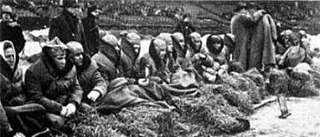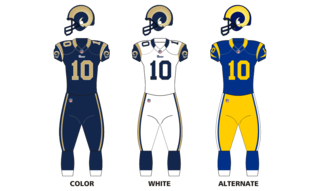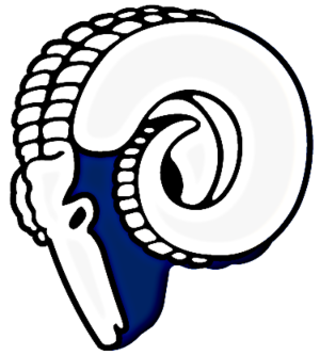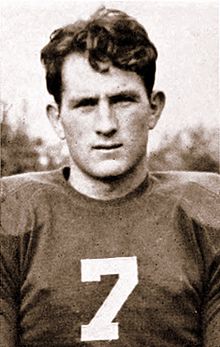
The All-America Football Conference (AAFC) was a major professional American football league that challenged the established National Football League (NFL) from 1946 to 1949. One of the NFL's most formidable challengers, the AAFC attracted many of the nation's best players, and introduced many lasting innovations to the game. However, the AAFC was ultimately unable to sustain itself in competition with the NFL. After it folded, three of its teams were admitted to the NFL: the San Francisco 49ers, the Cleveland Browns and the original Baltimore Colts.

Robert Stanton Waterfield was an American football player and coach. A skilled player, he played in the National Football League (NFL) for eight seasons, primarily as a quarterback, but also as a safety, kicker, punter and sometimes return specialist with the Cleveland / Los Angeles Rams. He played college football for the UCLA Bruins. He was inducted into the Pro Football Hall of Fame in 1965. His No. 7 jersey was retired by the Rams in 1952. He was also a motion picture actor and producer.

The 1945 NFL Championship Game was the 13th National Football League (NFL) championship game. Held on December 16, the Cleveland Rams defeated the Washington Redskins 15–14 at Cleveland Stadium in Cleveland, Ohio.

Daniel Farrell Reeves was an American sports entrepreneur, best known as the owner of the National Football League (NFL) franchise Los Angeles Rams. He owned the franchise when it was operating in Cleveland, Ohio in 1941, and he would own the team until his death in 1971.

Thomas Jesse Fears was a Mexican-American professional football player who was a split end for the Los Angeles Rams in the National Football League (NFL), playing nine seasons from 1948 to 1956. He was later an NFL assistant coach and head coach of the New Orleans Saints, and is in the Pro Football Hall of Fame. He played college football for the UCLA Bruins football team and is a member of the College Football Hall of Fame.

James Warren Benton was an American football player. He played professionally in the National Football League (NFL) with the Cleveland / Los Angeles Rams and the Chicago Bears between 1938 and 1947. Benton was the first NFL receiver to gain more than 300 yards in a game, a record that stood for 40 years. He was selected for the National Football League 1940s All-Decade Team.

The St. Louis Rams were a professional American football team of the National Football League (NFL). They played in St. Louis, Missouri from 1995 through the 2015 season, before moving back to Los Angeles, California, where the team had played from 1946 to 1994.
The 1951 NFL Championship Game was the National Football League's 19th championship game, played December 23 at the Los Angeles Memorial Coliseum in Los Angeles, California.

The 1950 NFL Championship Game was the 18th National Football League (NFL) title game, played on Sunday, December 24 at Cleveland Stadium in Cleveland, Ohio.
The 1950 National Football League playoffs took place after the 1950 regular season ended with a tie for first place in both the American and National conferences. The ties forced one-game playoffs to determine who would play in the NFL championship game. It was the only time in the NFL's championship game era that two such tiebreaker playoff games were needed in the same year. The Cleveland Browns and New York Giants tied for first place in the American Conference, while the Chicago Bears and Los Angeles Rams tied for first place in the National Conference. The Browns proceeded to beat the Giants 8–3, and the Rams beat the Bears 24–14 in their playoff game. Cleveland then beat the Rams in the championship game the following week. The home teams won all three games in this postseason.

William Franklin Conkright, known more commonly by the nickname "Red", was an American football center and end who played eight seasons in the National Football League (NFL) and was later the head coach of the Oakland Raiders for part of the 1962 season.

The 1951 Los Angeles Rams season was the team's 14th year in the National Football League and the sixth season in Los Angeles. In 1951, the Rams had an up-and-down season, never winning more than three games in a row, but were able to win eight games and clinch the National Conference after defeating the Green Bay Packers during Week 12 of the season. Los Angeles also led the National Football League in attendance for the second time while in Southern California; the first of 10 consecutive seasons leading the league in attendance. The Rams' largest crowd during the 1951 campaign was 67,186 against the Cleveland Browns during Week 2.

The 1946 Los Angeles Rams season was the team's ninth year with the National Football League and the first season in Los Angeles. The team moved to Los Angeles from Cleveland immediately after winning the 1945 NFL Championship Game.
The 1945 Cleveland Rams season was the team's eighth year with the National Football League and the ninth and final season in Cleveland. Led by the brother tandem of head coach Adam Walsh and general manager Chile Walsh, and helmed by future Hall of Fame quarterback Bob Waterfield, the Rams franchise finished 9–1 before winning its first NFL Championship by defeating the Washington Redskins, 15–14, at Cleveland Stadium. Other stars on the team included receiver Jim Benton and back Jim Gillette, who gained more than 100 yards in the title game.
The American Football League (AFL) was a professional American football league that operated in 1936 and 1937. The AFL operated in direct competition with the more established National Football League (NFL) throughout its existence. While the American media generally ignored its operation, this second AFL was the first "home" of the Cleveland Rams, which joined the National Football League after one year in the AFL.
Homer Marshman was the first owner of the Cleveland Rams, now known as the Los Angeles Rams. Mr. Marshman, a prominent Cleveland, Ohio lawyer and businessman who received his law degree from Harvard School of Law, served as special counsel to Ohio's attorney general from 1934 to 1947. He founded the Rams along with player-coach Damon "Buzz" Wetzel in 1936, when it played one successful yet financially disastrous year in the American Football League, then acquired a National Football League franchise for the team on February 13, 1937. Marshman and the other Rams stockholders paid $10,000 for the NFL franchise, then put up $55,000 to capitalize the new club.
The Los Angeles Rams are a professional American football team that plays and competes in the National Football League (NFL). The Rams franchise was founded in 1936 as the Cleveland Rams in the short-lived second American Football League before joining the NFL the next year. In 1946, the franchise moved to Los Angeles. The Rams franchise remained in the metro area until 1994, when they moved to St. Louis, and were known as the St. Louis Rams from 1995 to 2015. The Rams franchise returned to Los Angeles in 2016. This article chronicles the franchise's history during their time in Los Angeles, from playing at the Los Angeles Memorial Coliseum between 1946 and 1979, to playing at Anaheim Stadium in Anaheim from 1980 to 1994, and its return to Southern California beginning with the 2016 to 2019 seasons playing temporarily at their old home the Los Angeles Memorial Coliseum before moving to SoFi Stadium in Inglewood in 2020 alongside the Los Angeles Chargers.

Donald Adams Greenwood was an American football player and coach. He played professionally as a back for three seasons with the Cleveland Rams and the Cleveland Browns in the National Football League (NFL) and All-America Football Conference (AAFC).













